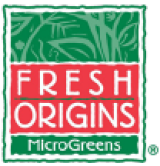


Oyster Leaf
Estimated Inventory, 50 ct : 1.00
This item was last sold on : 07/10/25
| Fresh Origins | Homepage |
Description/Taste
Oyster leaf is small to medium in size, measuring approximately 5 to 7 centimeters in length and 3 to 5 centimeters in width. The leaves are oval with smooth and sometimes ribboned edging and one central vein, giving the leaf a folded appearance. The leaves have a muted blue-green color, a waxy and powdery complexion, and a thick succulent texture. Oyster leaf has an earthy aroma and a watery nature with a briny, earthy, and mineral flavor reminiscent of oysters and other ocean bivalves.
Seasons/Availability
Oyster leaf is available year-round.
Current Facts
Oyster leaf is harvested from a perennial herb related to borage, botanically classified as Mertensia maritima. The beautiful succulent is also known as oyster plant and sea bluebells and grows wild in the harsh, cold seaside climates of the Northern Hemisphere. The leaves boast a juicy and succulent mouthfeel and a flavor similar to oysters, a marine bivalve. Oyster leaf is a part of a boutique line of specialty greens developed by Fresh Origins Farm in San Marcos, California. The plants are grown year-round and in-house in sprawling, sustainably-minded greenhouses. The leaves are designed to enhance the visual presentation of a variety of dishes while also adding a rich earthy and mineral flavor.
Nutritional Value
The nutritional composition of Oyster leaf has not been thoroughly studied, but the leaves were once believed to be a treatment for scurvy. Other members of the borage plant family contain high levels of gamma-linolenic acid, an omega-six fatty acid that aids with the reduction of inflammation within the body and contains high levels of vitamin C. This antioxidant supports the immune system and is the vitamin needed to ward off scurvy, potentially giving merit to the ancient medicinal use of the leaves.
Applications
Oyster leaf is best used fresh as an edible garnish to showcase the green’s briny and earthy flavor. The leaves provide a succulent crispness to dishes for increased textural and visual appeal and are traditionally added at the end of cooking as a finishing element to prevent the leaves from wilting. Oyster leaf can be tossed into salads, layered into sandwiches and wraps, chopped and folded into soft cheeses, dips, and spreads, or floated over soups and curries. The leaves can be placed over tacos and tostadas, piled as a bed for fish or roasted meats, used as a garnish over sushi, or strewn across stir-fries for a fresh pop of flavor. In addition to using the leaf whole, Oyster leaf can be chopped and stuffed into pasta, blended into sorbet to create a cooling, palate-cleansing taste, or combined into salad dressings for an earthy and salty flavor. Oyster leaf pairs well with herbs such as basil, marjoram, mint, dill, and parsley, cheeses including gouda, goat, and ricotta, meats such as poultry, turkey, quail, and fish, alliums such as garlic and shallots, and citrus fruits. The leaves will generally keep 5 to 7 days when stored in the refrigerator in a sealed container.
Ethnic/Cultural Info
Oyster leaf has gained popularity during the 21st century as veganism, and the push for interesting vegan alternatives continues to grow. Veganism is a diet of only plant-based ingredients, and the lifestyle has seen a 40% increase since 2020, leading to an increased demand for innovative and flavorful plant-based dishes at fast-casual and upscale restaurants across the United States. Many chefs have witnessed first-hand the growing need for new and exciting uses of fruits and vegetables to create flavorful vegan options on their menu. Oyster leaf serves this function perfectly as a unique and stunning sensory ingredient, mimicking a flavor many would have experienced before their dietary change that they may have thought lost in the plant-based world. Chefs can use this beautiful leaf to create dishes reminiscent of the popular bivalve that cater directly to those seeking a plant-based alternative.
Geography/History
Oyster leaf is native to the northern coasts of Britain and Europe, growing wild along the coast of Scotland and Shetland. The plant thrives in a wet, sub-arctic climate, exposed to frigid temperatures and ocean waves. Oyster leaf is grown throughout the Northern Hemisphere, as far north as Canada and Greenland. Oyster leaf is also produced by Fresh Origins, a farm in San Marcos, California, the leading producer of naturally grown microgreens since the mid-1990s. Fresh Origins also has the highest level of a third-party-audited food safety program and is a certified member of the California Leafy Greens Marketing Agreement, which follows science-based food safety practices to promote transparency and honesty in production. The temperate climate of southern California allows Fresh Origins to produce high-quality greens year-round, supplying produce retailers and chefs directly throughout the United States and Canada.
Featured Restaurants
Restaurants currently purchasing this product as an ingredient for their menu.
| Le Coq | La Jolla CA | 858-427-1500 |
| Addison Del Mar | Del Mar CA | 858-350-7600 |
| Mission Pacific | Oceanside CA | 760-450-7864 |
| Wormwood | San Diego CA | 619-573-0289 |
| Kingfisher | San Diego CA | 619-861-8074 |
Recipe Ideas
Recipes that include Oyster Leaf. One
| Cooked |
|
Roasted Oysters with a Seawater Emulsion and Oyster Leaf |
| Judd Servidio |
|
Oyster Leaf with Salmon |




 Learn More...
Learn More...
